Coarse vs fine cottons in tailoring
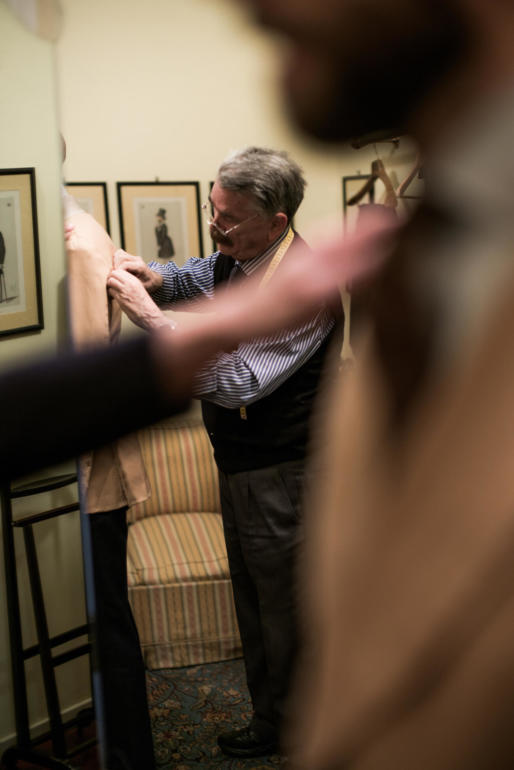
We covered the appeal of cotton as a tailoring material generally last week, but didn't talk about the different types of cottons.
There are corduroys and moleskins of course, gabardines and seersucker. But a difference I find particularly interesting - and one which is rarely discussed - is between fine and coarse cottons.
The jacket pictured being fitted here, at Ferdinando Caraceni in Milan, is in a much coarser (as well as heavier) cotton than the Caliendo.
It is a vintage Winterbotham cloth that Nicoletta Caraceni had in the atelier. (Ferdinando Caraceni liked and used to make a lot of cotton jackets and suits).
But what makes it coarse? Several things:
- First the fibre itself, which just like a wool can be finer or thicker.
- Second, the yarn it is spun into. A fine fibre can be spun into a finer yarn, but it doesn't have to be. A thicker fibre can only be spun into a thicker yarn.
- Third, how it is woven. You can weave in difference patterns, settings etc, all of which affect the feel of the cloth. A gabardine, for example, is a tight twill weave, which creates a harder, smoother feel than a normal twill.
- Fourth, the finishing. Finishing is a massive area, including things like how a cloth is washed, with how much soap, whether it is milled, whether it's brushed, cut down, etc. Less finishing normally goes into a cotton than a wool though.
Of these four areas, the most important to our comparison of cottons are the fibre and the finishing. A coarser yarn determines a lot of things further up the process; and finish drives a lot of the feel of the material.
Thirty years ago, far more cottons were made like this. Then the trend became for finer and finer cloths, in cotton as in wool.
"Those old English cottons were popular because people wanted a heavier, better wearing cloth," says Michael Day, head of production at Scabal in Brussels. "Back then if you had a 230g cotton, people would have thought it was a shirting rather than a suiting. You'd certainly never make a pair of trousers out of it."
"That market does exist today, and it has been growing a little, but it's still a very small part of the whole," continues Michael. "We don't offer it - it would be a little too niche and take a lot to communicate the value to the customer."
Some mills do still offer such cottons, including Eurotex, Fox Flannel and a handful of Huddersfield mills including Hunt & Winterbotham.
Having defined the cloth, then, how does this one differ in feel and performance from the finer cottons more normally used for tailoring?
Unsurprisingly, it's more similar to a denim or heavier, unwashed chino. Not as stiff as a raw denim by any means, but still untreated and unwashed, and therefore likely to age in a different way, softening more noticeably over time.
As mentioned, Ferdinando Caraceni used to make a lot of cotton jackets, and Nicoletta still wears a lot of her father's old ones. They have worn in like jeans - softening around the wear points, losing dye and feathering in the elbows and lower back.
I find it very appealing, and in a different way to the Caliendo cotton discussed previously. It feels more practical, almost like workwear, and I plan to wear it enough to beat it into a similar shape as Nicoletta's.
Like the Caliendo, this jacket will also have unlined sleeves, and finishing that is particularly nice around the edges and inside of the cuffs.
You can see the inside of an old model in the photo above. "My father always said that a jacket should be just as beautiful on the outside as the inside," Nicoletta has told me more than once.
And this is particularly true of cotton: "Cotton is a cheap material, so he always said it must be particularly fine in finish, to elevate this everyday material into something higher."
Photography: Luke Carby


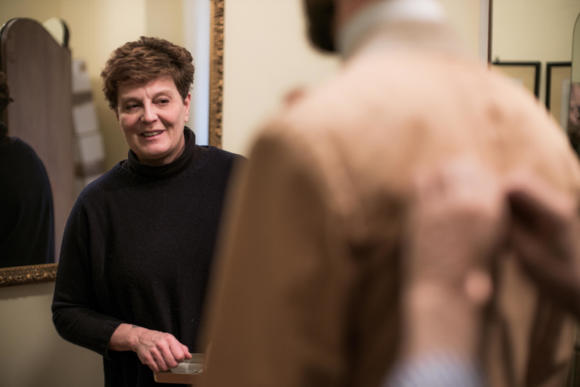
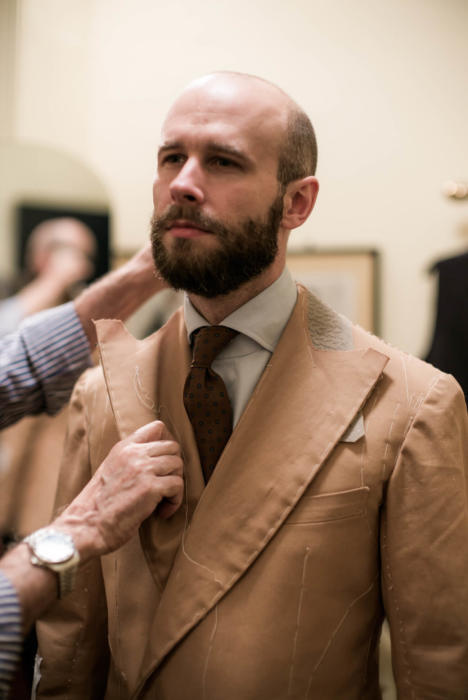
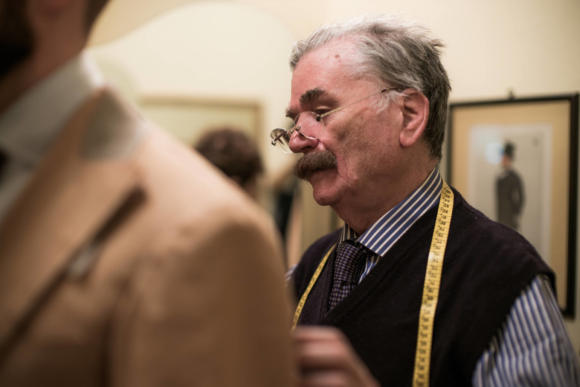
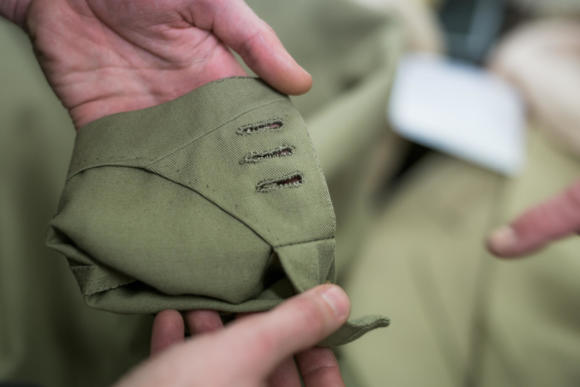
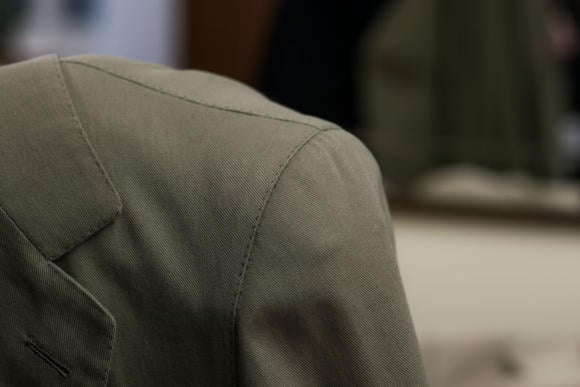
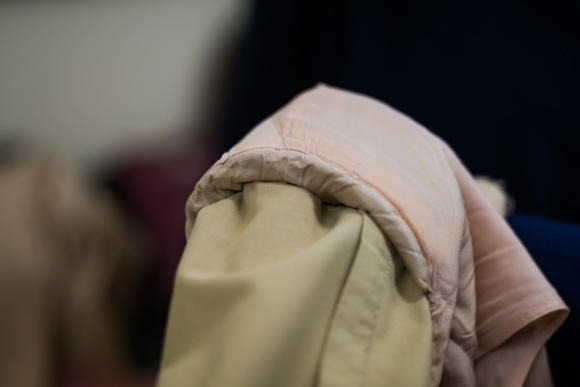

























Beautiful colour, to go with what colour trousers? Blue or maybe green?
Brown?
Mid-grey. Tried it against flannel and fresco, works very nicely.
But it’s quite a strong colour so needs something muted to soften it.
Why not even trousers in the same material of the coat?
Would be a great suit!
It would, I should have thought about that at the time!
Simon,
I have had problems with lighter weight cotton suit trousers becoming bulgy over the knees, as you sit while wearing the trousers. Due to this experience I would probably not go for bespoke cotton suits again. Is this the case generally for light weight cotton or for most types/weights of cotton fabric?
Thanks,
Patrik
It varies a lot with types of cotton. A lightweight or softer cotton will bag more, eg moleskin or corduroy. A tight weave like a gabardine will hardly do so at all
Hi Simon,
Excuse the off topic question. Are there any relatively affordable RTW brands that make shirt collars that are tall-ish semi spread or forward point?
I’m trying to budget, but with a head the size of Siberia, it’s hard to find collars that arent short point, and short height spreads, or cutaways. My neck looks too long and it does no favours for my head.
Was hoping there might be cheaper options than getting a shirt made for me.
Thanks.
Nothing springs to mind, no. Though have you considered Simone Abbarchi (if in London or New York)? He’s the same price as a lot of high end RTW shirts
Alas, I live in Sydney.
Thankyou nonetheless, I’ll just have to get one made to experiment, and if I find some I’ll let other readers know.
I would love a column on how to care for clothing, especially at home cleaning methods, or a link if you have already discussed. I enjoy caring for my nice clothes myself. I love your blog! We used to have Frost Bros. in town, and they had the most beautiful clothing. Long gone!
You evaded any direct opinion on cotton seersucker jackets. ?
Hi Simon: in addition to a corduroy, I was also thinking of a suit in heavier cotton like Nicoletta has made for you. What is the weight of “heavier cotton”? The Huddersfield Fine Worsted website shows their cotton drill swatches with weights ranging from 220 grams to 290 grams. The categorized this spectrum as lightweight. Thoughts?
This is certainly light in weight, but the biggest difference in my Caraceni one was the thickness of the fibre and therefore the yarn. This is normally heavier in weight but isn’t always. I don’t know what the weave and yarn is like on those HFW ones, but it sounds more like my Caliendo cotton than the Caraceni
How heavy is this cotton?
You spoke about it being heavier but didn’t find the weight.
It was vintage and without any description, so without weighing it before it’s hard to say for sure. But I’d say around 13oz
I’m considering commissioning a suit in a very similar buttery color in 10.5oz but a bit hesitant since everyone keeps trying to talk me out of cotton and into linen.
Do you feel a single breasted cotton suit in this color is worthwhile? Something to wear vacationing and less formal California summer wedding parties?
Yes, absolutely. See all my posts on cotton suits – very comfortable, great casual look, but terrible to tailor
Do you feel 10.5oz is too heavy?
No
Hello Simon, are you familiar with the Brisbane Moss cotton range? They have a 400g twill bunch called Keats that is published online, and I wondered where that would fall in your coarse/fine spectrum. Do you have a view on how it would do for a full suit? Fox don’t seem to carry heavier cottons at the moment, and neither do Huddersfield Fine Worsteds (in their online Cotton & Linen bunch). Thanks much!
It would fall towards the finer end of the spectrum, like most modern cottons.
In a full suit it might be a little to heavy and stiff.
Thank you Simon. So the “lean towards heavy” rule of thumb, if there ever was one, does not necessarily hold for cotton (as e.g. for linen). I just ordered 475g grey Fresco trousers from Max/Pasinato and am fairly excited.. very pleasing encounter btw, following your recent post. Looking forward to the finished suit review.
Nice to know, thanks Oskar
Hi Oskar, 475 gr. Fresco has fulfilled your expectations?
What are the pros and cons of a moleskin suit or jacket? You almost never see one. Is it because moleskin looks odd i.e. has the aesthetics of workwear, because it’s harder to tailor or because it wears to warm compared to corduroy? The fabric seems to be restricted to trousers. Still it’s said to be very hardwearing. So one should think it has some advantages compared to other cottons e.g. corduroy. Holland&Sherry make a lovely midweight 400 g / 14 oz moleskin which I wonder would be a good idea to have made up as a jacket. What are your views on this, Simon? Thank you!
Corduroy was also originally a workwear fabric, but neither really wear as well as you would expect today – they might not wear through, but they’ll look worn.
As to a suit, it would just have the disadvantages of a heavy cotton, lacking stretch and being a little stiff. Otherwise vs corduroy it’s mostly just a question of fashion
Hi Simon,
When looking at trouserings, I see cotton twill & cotton drill. Is cotton drill a subset of twill, except more tightly woven, and as a result, more stiff and hardy?
My best,
Bernie
Yes. Twill is just describing the weave pattern, but a lot of things are twills (including jeans!)
Hi Simon!
I wonder in terms of for cotton suits whether or the fabric should be pre-washed before construction, and what the pros and cons of each were, and which you preferred?
W
Most of the time tailors will pre-wash them, yes. Although it’s more of a soak than the kind of wash we’d do at home in the machine.
This is really just to get rid of shrinkage and a little starch. The material can also be more properly washed, which will make it softer, but it’s often nicer if this is done once the suit is made up, so you also get a little fading around the edges and seams
Ah okay thanks Simon! I’m assuming then that the suit doesn’t have any canvas etc attached when it is washed?
No it will do – when the suit is made up, I meant dry cleaned rather than washed.
Hi Simon – Assume it is the Fox Khaki bunch you refer to that make similar coarse cottons? Do you know the bunches from Eurotex or other Huddersfield mills that would also be similar? Cheers
I’m afraid not Leo, no, it was the vintage cotton trousers I had from Fox here. I don’t think they currently offer that.
I don’t know any other bunches that have coarser cottons off hand, sorry. They don’t tend to be the priority for most mills.
Argh shame! Any recs for someone who can’t go down the vintage rabbit hole and wants to get a cotton suit (that isn’t flimsy, shiny etc)?
I still think the finer cottons here are good, but they’re definitely a different aesthetic – they’re not shiny, but they are finer, not as tough